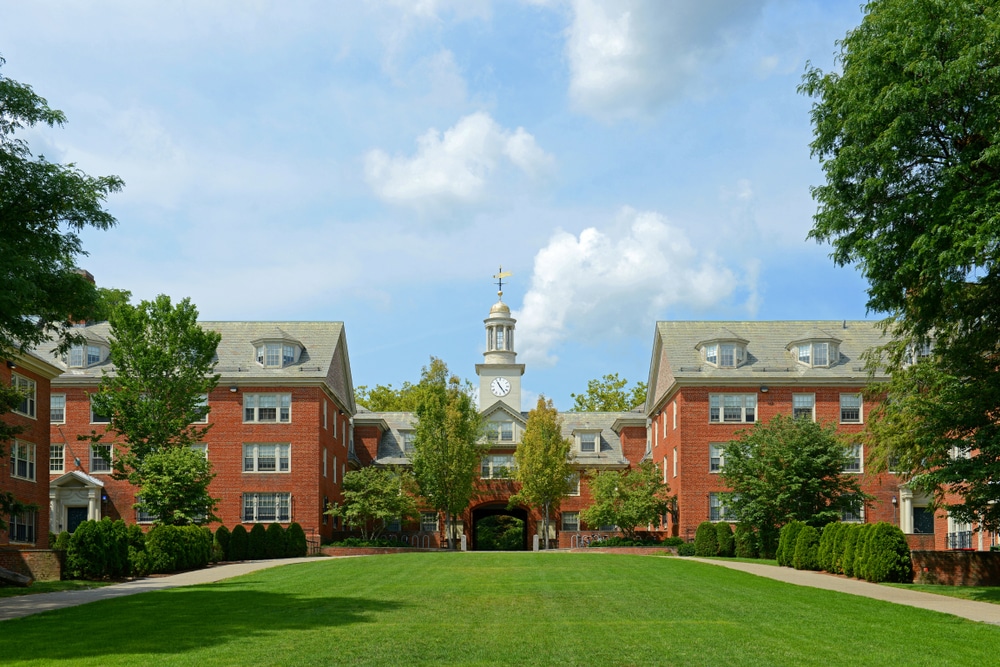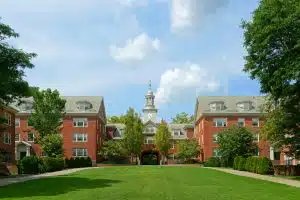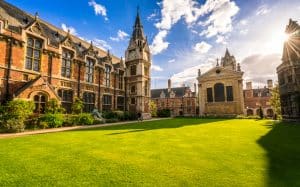Brown Campus Tour
In academia, where the pursuit of knowledge intertwines with architectural marvels, the Brown campus tour beckons as a gateway to enlightenment. Nestled within the vibrant city of Providence, Rhode Island, the esteemed Brown University opens its gates to an experience that transcends the ordinary and ushers visitors into a world of academic wonder.
Whether you’re a prospective student on a quest for higher learning, an eager traveler seeking intellectual exploration, or a curious soul eager to unravel the tapestry of history and innovation, the Brown campus tour awaits as an exceptional odyssey.
Is the Brown campus open to the public?
Is the Brown University campus accessible to the general public? The University opens its doors to visitors for the in-person Brown campus tour. Bringing back an important component of the application process for colleges and marking another step toward the normalization of the Office of Admission.
Brown University provides a variety of programs that are intended to educate prospective students about the academic experience, student life on campus, the financial aid process, and the admissions process. You will find a variety of opportunities listed below; many of these will give you a chance to network with current Brown students, who serve as the most authentic ambassadors of the institution.
Brown Campus Tour
The campus tour provides visitors with the opportunity to explore Brown’s campus while also gaining insight into the academic experience, notable campus landmarks, residential life, dining, and the history and traditions of Brown.
Walk around the picturesque New England college campus of Brown University with a current student while gaining insight into what it’s like to be a student there. You will have the opportunity to get answers to any questions you may have about life on College Hill from people who are currently residing there.
All campus tours require visitors to register in advance, and there is no assurance that the institution will be able to accommodate guests who have not done so. Please make sure that you indicate the correct number of visitors to your party so that available spaces can be allocated appropriately. There is a limit of three total visitors per registration, so please make sure that you indicate the correct number. At the time of registration, you will be asked to abide by the visitor policies of the university.
Sustainability Tour
Prospective students are educated about sustainable practices at Brown University, such as composting and recycling, as well as LEED buildings, local food, and alternative living options, during the Sustainability Tour.
Students currently enrolled at Brown discuss their experiences with sustainability initiatives on campus and ways that fellow students can get involved both in and outside of the classroom. The Brown University Office of Sustainability is in charge of putting on this tour.
Engineering Tour
The Engineering Tour takes students on a journey through the academic and extracurricular opportunities available to them in the field of engineering at Brown University. The tours are typically conducted by current engineering students and last for about a quarter of an hour.
Group Visit
The campus at Brown University is always full of people and activities. As a consequence of this, all groups are required to get in touch with the university first at [email protected] at least three weeks in advance to schedule a visit.
It is not guaranteed that a group will be allowed to take the Brown campus tour; however, providing more advanced notice may increase the likelihood that accommodations can be made. They are grateful for your flexibility with the tour and information session schedules that have been published; however, they are unable to guarantee a specific tour slot at all times.
Please be advised that, as a result of the high demand, their office is unable to offer group visit programming for students who have not yet reached the age of majority. On the registration form for the event, you will need to specify that you require accommodations due to a disability for those to be arranged.
COVID-19 Guidelines
Visitors and guests are permitted on campus without the need for any additional permissions or approvals; however, they are subject to the following expectations and provisions:
Vaccination of Visitors and Guests Requirement: By Sections 3.2.7 and 3.2.8 of this policy, visitors to Brown who are engaged in sustained and consistent in-person contact with other Brown employees, students, or visitors are required to be Up to Date with COVID-19 vaccines. This requirement applies to researchers, faculty, students, and other visitors who take the in-person Brown campus tour.
Any visitor of this kind who is not up to date is required to have a virtual interaction with the university. Visitors to the university are not eligible for exemptions granted based on medical necessity or religious conviction. On the other hand, if the guest has a disability, that person has the right to request an accommodation that is reasonable for their situation.
Mask Wearing
Mask-wearing is voluntary for all members of the community, regardless of whether or not they have been vaccinated, with the following exceptions where masking is mandatory:
- Facilities for the provision of medical care, including the Health and Wellness Center
- Courses in which the student’s participation is contingent on their donning of face coverings
Even though wearing a mask is voluntary, individuals who have been granted exemptions from vaccination can help reduce their risk of transmission by continuing to adhere to the masking guidelines that are recommended for use indoors, on shuttles, and in other public spaces.
Does Brown have a virtual tour?
Is there an online tour of Brown University available? Discovering Brown University without having to leave the convenience of your own home is now easier than it has ever been. There are many different ways to become familiar with Brown, and participating in some of the virtual events that are listed below will give you an idea of what it’s like to live on College Hill.
Virtual Brown Campus Tour
In addition to research opportunities, diversity on campus, student life, the application process, and financial aid, admission officers will provide in-depth information at presentations and other events titled “Introduction to Brown.” These events will be led by admission officers, and they will provide information about Brown’s rigorous and unique Open Curriculum.
You may also find opportunities to connect with academic departments and other campus partners to learn more about the many perspectives that make up the Brown community, as well as opportunities to engage in different spaces on campus and beyond. These opportunities may be found in the Brown Community Engagement Directory. Throughout the course of the year, new events will be added to the calendar.
Information Session
Learn about the academic experience, such as the open curriculum, advising, research, the application process, and financial aid, by watching a recorded information session that was presented by the Dean of Admission and admission officers.
How long is the Brown campus tour?
How long does the tour of Brown University’s campus take? The journey is expected to take somewhere in the neighborhood of an hour to complete. Spending more time on campus will allow you to get a better feel for the atmosphere and determine whether or not it is a good fit for you.
What can you see at Brown?
What kinds of things can you find at Brown? Brown University in Providence, Rhode Island, is a member of the illustrious Ivy League and was established in 1764. It is the seventh-oldest institution of higher education in the United States and was chartered before the start of the American Revolution.
Brick quadrangles, picturesque greens, towering modern architecture, renovated centuries-old structures, state-of-the-art laboratories, and world-class libraries are just some of the features that make up Brown University’s historic campus, which offers a classic New England college experience.
The following is a list of some of the most notable features of the campus:
College Street
Providence’s College Street has a long and illustrious history. On the west bank of the Providence River, this is the street that can be accessed directly from Memorial Boulevard to gain access to Brown University. Because the street was built before automobiles were common, it is very friendly to people who are walking. A stroll down College Street is a required component of any Brown campus tour.
Visitors will be able to view Memorial Park as they walk along College Street. This park is home to the Providence River Greenway, the Rhode Island Holocaust Memorial, and the World War I Memorial, which stands 150 feet tall.
John Hay Library
While taking the Brown campus tour, one of the best things to look forward to is the John Hay Library. On the campus of Brown University in Providence, the John Hay Library is the older of the two libraries that can be found there. It took the place of the previous library on campus, which had outgrown its space and is now known as Robinson Hall. The University Library currently comprises five separate libraries, with the John Hay Library being one of those libraries.
During the course of the American Civil War, John Hay was Abraham Lincoln’s private secretary. After the war, Hay was appointed Secretary of State. The John Hay Library now houses his papers as well as his collection of books and other reading materials.
Van Wickle Gates and the “Quiet Green”
The Van Wickle Gates serves as the campus’s main ornamental entrance in Providence, Rhode Island, and belongs to Brown University. They were dedicated on June 18, 1901, and continue to serve as a symbol for the campus and its history, which spans 251 years.
The gates are made of wrought iron and are supported by brick and stone piers. Hoppin & Ely and Hoppin & Koen, architects, were responsible for the design of the gates. The students on this campus have a superstitious belief that if they go through the center gate more than twice, they will not graduate. Members of groups that frequently pass through the gates, such as the Brown University Band, can avoid the rumored curse by entering the gates in a backward direction while hopping on one foot.
University Hall
The University Hall, a must-visit spot during the Brown campus tour, is the first and oldest building on campus. The building was constructed in 1770 and is one of only seven college buildings that are still standing that were constructed before the American Revolution. The building is considered to be “one of the genuine icons of early American collegiate architecture” by Bryant F. Tolles Jr., an expert on the history of architecture in the United States.
University Hall is a relatively unassuming and straightforward structure when compared to other academic buildings constructed around the same time.
Haffenreffer Museum of Anthropology Gallery
The Haffenreffer Museum of Anthropology at Brown University serves as the educational institution’s museum. On the campus of the university, the museum maintains a gallery that is 2,000 square feet (190 square meters) in size and is located in Manning Hall.
The museum’s gallery in Manning Hall, which is located in the middle of the Brown University campus, features rotating exhibitions that highlight the museum’s collections from all over the world as well as the work of Brown University faculty, staff, and students. In addition, the museum hosts public lectures, performances, symposia, festivals, and activities for schools, in addition to a wide variety of other programs and events for people of all ages.
Main Green
The Main Green is a large park that is located in the heart of the Brown University campus. Students frequently congregate there to study, picnic, and engage in other recreational activities. In addition to that, it is a frequent gathering place and venue for campus-wide special events.
Visitors to Brown University will notice that several students have taken up residence on the green, either to pass the time between classes or to simply take in the scenery and enjoy the day.
Sayles Memorial Hall
Another interesting stop on the Brown campus tour is Sayles Memorial Hall. It is a Richardsonian Romanesque structure, and it can be found on the university’s main campus in Providence. Alpheus C. Morse was responsible for the structure’s design, and construction took place between the years 1879 and 1881.
William Clark Sayles, who had attended Brown University but had passed away by the time Sayles Hall was constructed, died in 1876.
In 1878, Sayles’ father donated $50,000 to the university so that it could construct a building in his son’s honor. According to the terms of the donation, the building was to be “exclusively and forever devoted to lectures, recitations, and meetings on academic occasions.”
Faunce House
The historically significant structure, which used to be known as Rockefeller Hall, has recently been rechristened as the Stephen Robert ’62 Campus Center. The older building has been transformed into a recreation center for Brown University students as a result of the renovation.
In 1931, Rockefeller requested for the building to be expanded and renamed after Dr. William Herbert Perry Faunce. He wanted these changes to take place. Dr. Faunce was a prominent educator and clergyman in the United States. He served as president of Brown University from 1899 until 1929.
John Carter Brown Library
The John Carter Brown Library was established in 1846 and is managed independently from Brown University; however, it has occupied the same location on the university’s Main Green ever since 1904.
It is widely acknowledged to be the most comprehensive collection of primary historical sources relating to the Americas before the year 1825 anywhere in the world. It contains an extremely high percentage of the works that were published before that date that are concerned with the exploration, colonization, history, and natural history of the New World.
Annmary Brown Memorial
Annmary Brown Memorial, one of the best places to visit during your Brown campus tour, houses a mausoleum in addition to an art museum and a library. Architect Norman Isham of Rhode Island was responsible for the building’s design, and it was built between the years 1903 and 1907.
Its monumental bronze doors feature allegorical representations of art and learning, which tell visitors that the building houses a wealth of cultural treasures that are well worth discovering on the premises. The museum was originally founded as an independent collection by General Rush C. Hawkins and his wife, Annmary Brown, before it merged with the university in 1948.
Sciences Library
The building that houses the Sciences Library in Providence, Rhode Island, stands out as a remarkable piece of architecture due to the stark contrast it creates with the cityscape that is all around it. This structure is the world’s very first high-rise library. The building was given the nickname “SciLi.”
The Science and Language Institute (SciLi) Library houses a variety of departments and resources in addition to the library itself. These include the Center for Language Studies, the Writing Center, the Map Collection, the Interlibrary Loan office, and the Friedman Study Center.
Thayer Street
Thayer Street in Providence is not only steeped in history but also remains a popular destination during the Brown campus tour. In 1923, the area formerly known as Cross Street was rechristened Thayer Street in honor of Dr. Williams Thayer.
The first structure on this street was erected in 1799. Brown University students and locals gather on Thayer Street, which acts as a community hub for the two groups. Thayer Street is well-known for the large number of locally owned businesses and eateries that it is home to, in contrast to the situation in other university towns, where comparable streets have been taken over by chain stores.
Pembroke College
Pembroke College was established in 1891 in response to the fact that women were barred from enrolling in higher education programs at the time of Brown University’s founding. In 1971, it became a part of Brown University.
Mare de St. Pol, Countess of Pembroke, was the woman responsible for establishing the first Pembroke Hall. Pembroke Hall has been transformed into the Cogut Center for the Humanities and the Pembroke Center for Teaching and Research on Women in recent years.
Alumnae Hall, Andrews Hall, the buildings of the Pembroke Quad, and the buildings of New Pembroke are some of the other buildings that can be found on the campus of Pembroke College.
The Brown campus tour may be one of the things that pique your interest in attending the university. Brown University, which is the seventh-oldest higher learning institution in the United States, holds the distinction of being the first college in North America to accept students regardless of the religious affiliations they held.
At 5%, it has one of the most selective admissions rates in the country, and the number of students enrolled in its undergraduate program is very close to reaching 10,000. You will require aid from college admissions professionals like AdmissionSight if your objective is to be admitted to Brown.
We at AdmissionSight have more than ten years of experience helping students navigate the challenging admissions process so they can enroll in the best colleges in the world. Feel free to schedule a consultation session today.











































